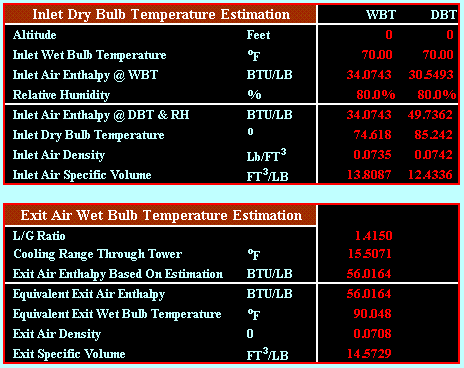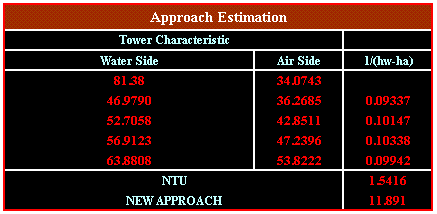|
Example 13-2. Check the result if the cold water
temperature obtained from example 13-1 is correct.
(Solution)
The actual cold water temperature obtained from example
13-1 is exactly same as the combine temperature of cold
water temperature through the tower and hot water temperature
of by-pass wall water.
Cold Water Temp. through
Tower (Ctemp) = Wet Bulb Temp. + Approach + Design Range
- New Range
Hot Water Temp. of By-Pass
Wall Water (Btemp) = Ctemp + New Range
Final Cold Water = (Ctemp
x Water Flow through Tower + Btemp x By-Pass Wall Water
Flow) / Water Flow
= (Ctemp x Water Flow x (1 - %BP) + Btemp x Water Flow
x %BP)/ Water Flow
= Ctemp x (1 - %BP) + Btemp x %BP
= Ctemp x (1 - %BP) + (Ctemp + New Range) x %BP
= Ctemp - Ctemp x %BP + Ctemp x %BP + New Range x %BP
= Ctemp + New Range x %BP
= WBT + Approach + Design Range - New Range + New Range
x %BP
= WBT + Approach + Design Range - New Range x ( 1 -
%BP)
= WBT + Approach + Design Range - Design Range / (1
- %BP) x (1 - %BP)
= WBT + Approach
- Cold Water Temperature
Through Tower (Ctemp) = Actual Cold Water Temp. +
Range - Actual Range = 88.633 + 15.0 - 15.507 = 88.126oF
- Hot Water Temperature
into Tower (Btemp) = Ctemp + Actual Range or = Actual
Cold Water Temp + Range = Ctemp + 15.507 = 103.633oF
- Water Flow Through Tower
(W1) = Design Water Flow x ( 1 - % By-Pass
/ 100) = 12,500 x ( 1 - 3.27 /100) = 12,091.25 GPM
- By-Pass Water Flow without
Cooling (W2) =Design Water Flow x % By-Pass
/ 100 = 12,500 x 3.27 / 100 = 408.75 GPM
- Cold Water Temperature
at Water Basin = (W1 x Ctemp + W2
x Btemp) / (W1 + W2) = (12,091.25
x 88.126 + 408.75 x 103.633) / (12,091.25 + 408.75)
= 88.633oF
Example 13-3.
Check if the relation of HEATin = HEATout is established
from the above example
(Solution)
HEATin = Total Heat Removal from Water
= Water Flow Rate in GPM x ( 500 / 60 ) x Cooling Range
= 12,500 x ( 500 / 60 ) x ( 104 - 89 )
= 1,562,500 BTU/Min
or = Water Flow Through Tower
in GPM x (500 / 60) x Cooling Range Through Tower
= 12,500 x ( 1 - % By Pass / 100 ) x (500 / 60) x Cooling
Range / ( 1 - % By Pass / 100)
= 12,500 x ( 1 - 3.27 / 100 ) x (500 / 60) x 15 / (
1 -3.27 / 100)
= 1,562,500 BTU/Min
HEATout = Total Heat Gain
from Air
= Air Mass Flow in LB/Min x (Exit Air Enthalpy - Inlet
Air Enthalpy)
= 69,909.2 x (66.0411 - 43.6907)
= 1,562,500 BTU/Min
Example 13-4.
Determine L/G ratio and cold water temperature when
the wet bulb temperature was downed to 70oF
from design conditions described in the example 13-1.
(Solution)
First, find a dry bulb temperature for 80% of
relative humidity corresponding 70oF of wet
bulb temperature.
Second, find an exit
air temperature and air volume of fan until these are
ultimately equal.
Water Through Tower in LB/Min
= Water Through Tower in GPM x (500 / 60)
Air Mass in LB/Min = Air
Volume @ Fan / Specific Volume @ Fan
L/G ratio is obtained from
the relation of Water Through Tower in LB/Min / Air
Mass in LB/Min
Exit Air Enthalpy = Inlet
Air Enthalpy + L/G x Range Through Tower = Inlet Air
Enthalpy + {Water Through Tower x (500 / 60) / (Air
Volume @ Fan / Specific Volume @ Fan)} x Range Through
Tower
Net Fan Power = Motor HP
x (1 - Motor Minimum Margin) x Power Transmission Efficiency
= Air Volume @ Fan x Total Pressure / (Fan Efficiency
x 6356)
Third, calculate the
tower characteristic in accordance with above computed
results.
KaV/L = 1.864 x {1 / (L/G)}0.8621 x Fill Air Velocity-0.1902
x Fill Height = 1.864 x (1 / 1.4105)0.8621
x 578.9-0.1902 x 40.8764 = 1.3890
Total Kav/L = KaV/L @ Fill / (1 - % of Heat Transfer
at Rain & Water Spray Zone / 100) = 1.3890 / (1
- 9.9% / 100) = 1.5416


Fourth, determine
the NTU satisfying the value of tower characteristic
by the method of iteration with the change of approach
figure.

Therefore, Actual Cold Water
Temperature = Wet Bulb Temperature + Approach = 70 +
11.891 = 81.89 deg. F
|